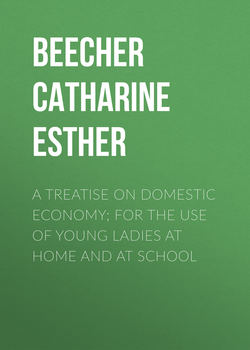Читать книгу A Treatise on Domestic Economy; For the Use of Young Ladies at Home and at School - Beecher Catharine Esther - Страница 9
CHAPTER V.
ON THE CARE OF HEALTH
MUSCLES
ОглавлениеThe muscles are the chief organs of motion, and consist of collections of fine fibres or strings, united in casings of membrane or thin skin. They possess an elastic power, like India rubber, which enables them to extend and contract. The red meat in animals consists of muscles. Every muscle has connected with it nerves, veins, and arteries; and those designed to move the bones, are fastened to them by tendons at their extremities. The muscles are laid over each other, and are separated by means of membranes and layers of fat, which enable them to move easily, without interfering with each other.
The figure on page 74, represents the muscles of the arm, as they appear when the skin and fat are removed. The muscles a and b are attached, at their upper ends, to the bone of the arm, and by their lower ends to the upper part of the fore arm, near the elbow joint. When the fibres of these muscles contract, the middle part of them grows larger, and the arm is bent at the elbow. The muscle c, is, in like manner, fastened, by its upper end, to the shoulder blade and the upper part of the arm, and by its lower end to one of the bones of the fore arm, near the elbow. When the arm is bent, and we wish to straighten it, it is done by contracting this muscle. The muscles d, d, are fastened at one end near the elbow joint, and at the other near the ends of the fingers; and on the back of the hand are reduced in size, appearing like strong cords. These cords are called tendons. They are employed in straightening the fingers, when the hand is shut. These tendons are confined by the ligament or band, e, which binds them down, around the wrist, and thus enables them to act more efficiently, and secures beauty of form to the limb. The muscles at f, are those which enable us to turn the hand and arm outward. Every different motion of the arm has one muscle to produce it, and another to restore the limb to its natural position. Those muscles which bend the body are called flexors; those which straighten it, extensors. When the arm is thrown up, one set of muscles is used; to pull it down, another set: when it is thrown forward, a still different set is used; when it is thrown back, another, different from the former; when the arm turns in its socket, still another set is used; and thus every different motion of the body is made by a different set of muscles. All these muscles are compactly and skilfully arranged, so as to work with perfect ease. Among them, run the arteries, veins, and nerves, which supply each muscle with blood and nervous power, as will be hereafter described. The size and strength of the muscles depend greatly on their frequent exercise. If left inactive, they grow thin and weak, instead of giving the plumpness to the figure, designed by Nature. The delicate and feeble appearance of many American women, is chiefly owing to the little use they make of their muscles. Many a pale, puny, shad-shaped girl, would have become a plump, rosy, well-formed person, if half the exercise, afforded to her brothers in the open air, had been secured to her, during childhood and youth.
